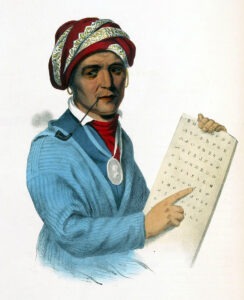
Sequoyah with a tablet depicting his writing system for the Cherokee language. Lehman and Duval (George Lehman (d.1870); Peter S. Duval) Painter: Henry Inman (1801-20-28 – 1846-01-17); copy after a painting by Charles Bird King (1785 – 1862) which was lost in a fire in the Smithsonian in 1865. Via WikiCommons.
Full Name: Ahyoka
Birth Date: Unknown
Death Date: Unknown
Ahyoka was the daughter of Cherokee native Sequoyah, the inventor of the Cherokee syllabary, and the first person to learn the written form of the language referred to as Tsalagi Gawonihisdi. Ahyoka’s name is roughly translated to “she brings happiness” in English.
Ahyoka plays a vital role in her father’s invention and its adoption by the Cherokee nation. There are two main stories circulated that people call the origin of Sequoyah’s invention. One is that he came up with the idea when he overheard fellow Cherokee natives talking about how white settlers communicated through writing or “talking leaves,” another is that he came up with the idea when watching non-native soldiers communicate through writing while serving in the War of 1812. Regardless of how the idea was inspired, Sequoyah would dedicate around 12 years to transcribing the Cherokee language to written form.
At first, Sequoyah started with pictographs and then decided to capture the language phonetically. The characters of the written language are considered a syllabary and not an alphabet because each character represents a syllable, whereas an alphabet’s characters represent phonemes, a smaller unit of sound. The creation of the written language was especially impressive as Sequoyah had no previous knowledge of reading and writing. Despite not being able to read English, he used the Bible and an English spelling book for inspiration on how to visualize his language.
So, how does Ahyoka come into this story? Well, Ahyoka is known as the first person other than Sequoyah to use the syllabary. Ahyoka learned it at the age of six and played a vital role in helping their tribe accept the invention. In fact, Sequoyah and Ahyoka were suspected of witchcraft by their tribe and forced to prove themselves. The two were separated and forced to use written communication to exchange messages, proving that their invention was legitimate. Furthermore, Sequoyah taught a group of people the language and split them into two to exchange messages much like he and his daughter did, once more demonstrating his invention was not witchcraft, and that it would be profoundly useful to their community.
A young Ahyokah would also play an important role in teaching the language alongside her father. In 1825, the Cherokee Nation claimed the language officially, and Cherokee literacy would skyrocket, exceeding that of their white neighbors. The phonetic-based language system made it more accessible to learn, whereas in the 1800’s, there was still a big class divide limiting literacy for English speakers.
Despite efforts to suppress the traditions and language of Natives and force them to assimilate through the passing of the Indian Removal Act and the institution of Indian boarding schools, the Cherokee syllabary remains to this day. In the 20th century, efforts to preserve the written language improved through the reintroduction of the Cherokee Phoenix newspaper (first published in 1828), the creation of a Cherokee-English dictionary, and modern-day gatherings to translate contemporary words into the language.
Today, you can visit Sequoyah’s Cabin Museum in Sallisaw, Oklahoma, to learn more about Sequoyah and his contribution to Native literacy and culture.
https://www.history.com/news/cherokee-sequoyah-written-language
